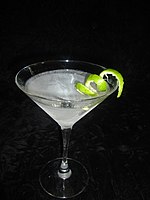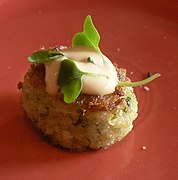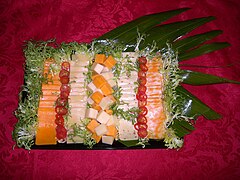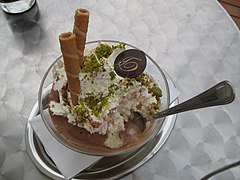Garnish (food)

A garnish is an item or substance used as a decoration or embellishment accompanying a prepared food dish or drink.[1] In many cases, it may give added or contrasting flavor. Some garnishes are selected mainly to augment the visual impact of the plate, while others are selected specifically for the flavor they may impart.[2] This is in contrast to a condiment, a prepared sauce added to another food item primarily for its flavor. A food item which is served with garnish may be described as being garni, the French term for "garnished."
Many garnishes are not intended to be eaten, though for some it is fine to do so. Parsley is an example of a traditional garnish; this pungent green herb has small distinctly shaped leaves, firm stems, and is easy to trim into a garnish.
Overview[]
A garnish makes food or drink items more visually appealing.[3][4] They may, for example, enhance their color,[3] such as when paprika is sprinkled on a salmon salad. They may provide a color contrast, for example when chives are sprinkled on potatoes. They may make a cocktail more visually appealing, such as when a cocktail umbrella is added to an exotic drink, or when a Mai Tai is topped with any number of tropical fruit pieces. Sushi may be garnished with baran, a type of plastic grass or leaf. Sometimes a garnish and a condiment will be used together to finish the presentation of a dish; for example, an entrée could be topped with a sauce, as the condiment, along with a sprig of parsley as a garnish.[citation needed]
A garnish may be so readily identified with a specific dish that the dish may appear incomplete without the garnish. Examples include a banana split sundae with cherries on top or buffalo wings served with celery stick garnish and blue cheese dressing.[citation needed]
List of garnishes[]
This section needs additional citations for verification. (February 2021) |
Foods and entree[]
Garnishes for foods and entrees include:

- Amandine – a culinary term indicating a garnish of almonds
- Bawang goreng – crisp fried shallot, a common garnish in Indonesian cuisine
- Caviar[5]
- Celery
- Chives[6][7]
- Chili pepper – julienne, rings or decoratively sliced
- Cilantro – coriander leaves
- Crouton
- Cucumber – julienne, rings or decoratively sliced
- Duxelles
- Egg garnish
- Fried onion – used as a garnish on steaks and other foods[8]
- Gremolata[9]
- Lemon basil
- Radish
- Manchette
- Microgreens – young vegetable greens that are used both as a visual and flavor component, ingredient and garnish[10]
- Mint[11]
- Nuts
- Olive oil – drizzled olive oil is used to garnish some foods[12]
- Ginger[13]
- Parsley[14]
- Persillade[15]
- Sautéed mushrooms – used on steaks and other foods[16][17]
- Edible seaweed – such as shredded nori sheet, used to garnish foods such as soups, entrees and sashimi[18][19]
- Sesame seeds [20]
- Walnut
Desserts and sweets[]
Garnishes for desserts and sweets include:

- Caramel
- Chocolate (shaved or curled)
- Cocoa powder
- Flaked coconut[21]
- Confetti candy
- Coulis (raspberry coulis, for example)
- Edible flowers
- Sliced fruit
- Gomul
- Honey
- Maraschino cherry
- Mint
- Sprinkles
- Syrups
- Vark
- Wafer
- Nuts[22]
- Walnut pieces and candied walnuts
- Wedding cake topper
- Whipped cream
Beverages[]
Garnishes for beverages include:

Coffee-based drinks may have:
- Cinnamon sticks or ground powder
- Cocoa powder
Savory drinks such as Bloody Mary may have:
- Carrot sticks
- Celery stalks (usually with leaves attached)
- Pepper
- Salt, coarse (applied to the rim of glasses)
Eggnog may have:
- Nutmeg, grated
Various fruits are used:
- Cherries
- Lemon slice, twist, or wedge
- Lime slice, twist, or wedgee
- Orange slice, twist, or wedge
- Pineapple slice or wedge
- Strawberries
- Watermelon wedge
- Cocktail garnish
- Cocktail onion
- Cocktail umbrella
- Green olive
- Mint[23]
- Twist
- Sugar, granulated or powdered
Garnishes according to cuisine traditions[]
This section needs additional citations for verification. (February 2021) |
French garnishes[]
Classic French garnishes include[24]
For soups:

- Brunoise – one to three mm diced vegetables
- Chiffonade – finely shredded lettuce or sorrel stewed in butter
- Croutes – small pieces of halved French bread buttered and oven dried
- Coulis – (a thicker soup) drizzled decoratively
- Croutons – small pieces of bread (typically cubes) fried in butter or other oil
- Julienne – thinly sliced vegetables
- Pasta (tapioca, sago, salep) etc.
- Pluches – a whole leaf spray of herbs, without the central stalk (traditionally chervil)
- Profiterolles – puff pastry stuffed with purée
- Royale – a small decoratively shaped piece of egg custard (in German this is called an Eierstich)
- Threaded eggs [25]
For relevés and entrées:
- Croquettes
- Potatoes (pommes dauphine,[26] Duchess potatoes or Marquis)
- Duxelles – fried onion, mushrooms and herbs[27][28]
- Matignon – minced carrots, onions, and celeries with ham stewed in butter and Madeira
- Mirepoix – similar to Matignon but diced (cf. minced) with or without ham (or with bacon substituted for the ham)
- Polonaise – Polish-style garnish with melted butter, bread crumbs, chopped boiled egg, lemon juice and herbs over cooked vegetables
- Salpicon – a variety of other diced meats or vegetables
- Fritters
Indonesian garnishes[]

- Bawang goreng – crisp fried shallot, a common garnish in Indonesian cuisine[29]
- Young carrot leaf
- Celery – locally known as daun seledri used as topping for soups or rice congee
- Chili pepper – sliced decoratively
- Cilantro
- Cucumber – sliced decoratively
- Flaked coconut – grated coconut flesh, usually used in traditional kue sweet dessert snacks; such as klepon, putu and lupis
- Emping – melinjo nut crackers
- Krupuk – various traditional crackers
- Lemon basil – locally known as daun kemangi
- Tomato – sliced decoratively
Japanese garnishes[]

- Beni shōga – julienne pickled ginger, usually used as a garnish for gyudon and okonomiyaki
- Gari – marinated thinly sliced ginger, usually used as a garnish for sushi and sashimi
- Katsuobushi – dried bonito flakes, usually used as a garnish for takoyaki
- Scallion or tree onion (wakegi) – mostly used as topping of tofu and miso soup
- Various edible seaweed – including thinly sliced nori sheets, used mostly as topping of ramen, udon or soba
- Sesame seeds – sprinkled on steamed rice or noodles
- Shiso leaf
Korean garnishes[]

In Korean cuisine, decorative garnishes are referred to as gomyeong (고명), means to decorate or embellish food.[30][31]
- Chrysanthemum leaves [32]
- Egg garnish – a common topping in Korean cuisine, made with egg whites and egg yolks.[33][34][35]
- Gochu – red chili pepper[36]
- Chili thread – a traditional Korean garnish made with chili peppers.[37][38][39]
- Crushed garlic[32]
- Green onions [32]
- [36]
- Scallions [36]
- Shiitake[36]
- Shredded vegetables [40]
Garnish tools[]
Tools often used for creating food garnishes include skewers, knives, graters, toothpicks, and parchment cones.[41]
Gallery[]
Fried onions are used as a garnish

A chocolate cake garnished with violets

A slice of butter cake garnished with sliced almonds

Egg Biryani garnished with cilantro

A cappuccino garnished with cocoa powder
Ice cream garnished with pistachio pieces and rolled wafers

A crabcake with a cream sauce and a garnish of microgreens

Cheese tray garnished with red pepper rings and chicory

A Bloody Mary with several garnishes

A wedding cake topped with a wedding cake topper

A partially-eaten loaf of lemon-flavored polenta cake, glazed and garnished with crushed freeze-dried raspberry.
See also[]
- Cake decorating
- Cocktail garnish
- Food presentation
- Garde manger
- Hors d'oeuvre
- Tuile
References[]
- ^ "Garnish". Encyclopedia Britannica. May 27, 2017. Retrieved May 28, 2017.
- ^ "Garnish". Food Encyclopedia. Food Network. Retrieved 1 September 2012.
- ^ Jump up to: a b Niz, Ellen Sturm (October 2, 2014). "How to plate your food like a pro: Celebrity chefs share their secrets". Today. Retrieved May 28, 2017.
- ^ "How To Garnish The Easy Way!". VegetableFruitCarving.com. Retrieved 1 September 2012.
- ^ Goldstein, D. (1999). A Taste of Russia: A Cookbook of Russian Hospitality. Russian Life Books. p. 71. ISBN 978-1-880100-42-4. Retrieved May 28, 2017.
- ^ Creasy, R. (2015). Rosalind Creasy's Recipes from the Garden: 200 Exciting Recipes from the Author of the Complete Book of Edible Landscaping. Tuttle Publishing. p. 77. ISBN 978-1-4629-1793-8. Retrieved May 28, 2017.
- ^ Hemphill, J.; Hemphill, R. (1997). What Herb Is That?: How to Grow and Use the Culinary Herbs. Stackpole Books. p. 18. ISBN 978-0-8117-1634-5. Retrieved May 28, 2017.
- ^ Rivers, F. (1916). The Hotel Butcher, Garde Manager and Carver. Home economics archive--research, tradition and history. Hotel Monthly Press. p. 105. Retrieved May 27, 2017.
- ^ Restino, S. (1996). Mrs. Restino's Country Kitchen. Shelter Publications. p. 148. ISBN 978-0-936070-18-6. Retrieved May 27, 2017.
- ^ Millard, E. (2014). Indoor Kitchen Gardening: Turn Your Home Into a Year-round Vegetable Garden. Cool Springs Press. p. 63. ISBN 978-1-61058-981-9. Retrieved May 28, 2017.
- ^ Authors, V. (2014). Eating For Victory: Healthy Home Front Cooking on War Rations. Michael O'Mara. p. 114. ISBN 978-1-78243-304-0. Retrieved May 28, 2017.
- ^ "Ramadan Special 2017: An Iftar Party Menu to impress your friends and family!". NDTV.com. May 27, 2017. Retrieved May 28, 2017.
- ^ Vartanian, A.; Potter, C.; Heino, K.; McClelland, R.; Ball, R.; Menegaz, V.; Kovacs, N.; Healy, H.; Castaneda, J.; Winters, K. (2015). The Ultimate Paleo Cookbook: 900 Grain- and Gluten-Free Recipes to Meet Your Every Need. Page Street Publishing. p. 221. ISBN 978-1-62414-140-9. Retrieved May 28, 2017.
- ^ The Hotel/motor Hotel Monthly. Clissold Publishing Company. 1913. p. 11-PA77. Retrieved May 28, 2017.
- ^ Fulton, M. (1986). Encyclopedia of food and cookery. Gallery Books. ISBN 978-0-8317-2799-4. Retrieved May 27, 2017.
- ^ Rombauer, I.S.; Becker, M.R. (1975). Joy of Cooking. Scribner. p. 456. ISBN 978-0-02-604570-4. Retrieved May 28, 2017.
- ^ Ruhlman, M.; Ruhlman, D.T. (2011). Ruhlman's Twenty: 20 Techniques, 200 Recipes, A Cook's Manifesto. Chronicle Books. p. 236. ISBN 978-0-8118-7643-8.
- ^ Aitken, H. (2008). The Really Useful Ultimate Vegarian Cookbook. Murdoch. p. 9. ISBN 978-1-74196-247-5. Retrieved May 28, 2017.
- ^ DK Eyewitness Travel Guide Japan. DK Publishing. 2017. p. 322. ISBN 978-1-4654-6432-3. Retrieved May 28, 2017.
- ^ Altschul, A.M.; Wilcke, H.L. (2013). New Protein Foods: Seed Storage Proteins. Food science and technology. Elsevier Science. p. 437. ISBN 978-1-4832-1597-6. Retrieved May 28, 2017.
- ^ Roehl, E. (1996). Whole Food Facts: The Complete Reference Guide. Inner Traditions/Bear. p. 115. ISBN 978-0-89281-635-4. Retrieved May 27, 2017.
- ^ Barrett, D.M.; Somogyi, L.; Ramaswamy, H.S. (2004). Processing Fruits: Science and Technology, Second Edition. CRC Press. p. 804. ISBN 978-1-4200-4007-4. Retrieved May 28, 2017.
- ^ DeGroff, D. (2010). The Craft of the Cocktail: Everything You Need to Know to Be a Master Bartender, with 500 Recipes. Potter/TenSpeed/Harmony. p. 107. ISBN 978-0-307-76227-6. Retrieved May 28, 2017.
- ^ Escoffier, A. (1941). Basic Elements of Fine Cookery. New York: Crescent Books. p. 88 et seq.
- ^ Raskin, X. (1922). The French Chef in Private American Families: A Book of Recipes. Rand McNally. p. 149. Retrieved May 28, 2017.
- ^ Picasso, P.; Foster, J.K. (1964). Posters. Grosset & Dunlap. p. 22. Retrieved May 28, 2017.
- ^ Spahr, D.L. (2009). Edible and Medicinal Mushrooms of New England and Eastern Canada. North Atlantic Books. p. 201. ISBN 978-1-55643-795-3. Retrieved May 27, 2017.
- ^ Boetticher, T.; Miller, T.; Farnum, A. (2013). In the Charcuterie: The Fatted Calf's Guide to Making Sausage, Salumi, Pates, Roasts, Confits, and Other Meaty Goods. Ten Speed Press. p. 256. ISBN 978-1-60774-343-9. Retrieved May 27, 2017.
- ^ Kruger, Vivienne (2014-04-22). Balinese Food: The Traditional Cuisine & Food Culture of Bali. Tuttle Publishing. ISBN 978-1-4629-1423-4.
- ^ Pettid, M.J. (2008). Korean Cuisine: An Illustrated History. Reaktion Books. p. 46. ISBN 978-1-86189-348-2. Retrieved May 28, 2017.
- ^ Helstosky, C. (2014). The Routledge History of Food. Routledge Histories. Taylor & Francis. p. 76. ISBN 978-1-317-62113-3. Retrieved May 28, 2017.
- ^ Jump up to: a b c Hayes, Dayle; Laudan, R. (2009). Food and Nutrition/Editorial Advisers, Dayle Hayes, Rachel Laudan. Food and Nutrition. Marshall Cavendish Reference. p. 615. ISBN 978-0-7614-7824-9. Retrieved May 28, 2017.
- ^ "al-gomyeong" 알고명. Standard Korean Language Dictionary (in Korean). National Institute of Korean Language. Retrieved 22 April 2017.
- ^ Korean Food Foundation (2014). The Korean Kitchen: 75 Healthy, Delicious and Easy Recipes. Seoul: Hollym. p. 46. ISBN 9781565914599. Archived from the original on 2017-04-22.
- ^ McWilliams, Mark, ed. (2013). Wrapped & Stuffed Foods: Proceedings of the Oxford Symposium on Food and Cookery 2012. Prospect Books. p. 236. ISBN 978-1-903-018-99-6.
- ^ Jump up to: a b c d Jin-ah, Y. (2015). K-FOOD: Combining Flavor, Health, and Nature. Korean Culture. Korean Culture and Information Service (South Korea). p. 79. ISBN 978-89-7375-599-8. Retrieved May 28, 2017.
- ^ "Korean chilli threads". . 12 August 2013. Retrieved 8 May 2017.
- ^ Kulshrestha, Kritika Pramod (9 October 2013). "Austin chefs create art inspired culinary bites". The Daily Texan. Retrieved 8 May 2017.
- ^ Bourke, Jordan; Pyo, Rejina (23 August 2015). "Six simple recipes from a Korean kitchen". The Guardian. Retrieved 8 May 2017.
- ^ Pettid, M.J. (2008). Korean Cuisine: An Illustrated History. Reaktion Books. p. 47. ISBN 978-1-86189-348-2. Retrieved May 28, 2017.
- ^ Joy, Dhanya. "Food Garnishing Ideas". Buzzle. Archived from the original on 15 December 2013. Retrieved 1 September 2012.
External links[]
| Wikimedia Commons has media related to Garnishing. |
- How to Garnish Food. WikiHow
- HowToGarnish.com
- Food and drink decorations
- Culinary terminology











